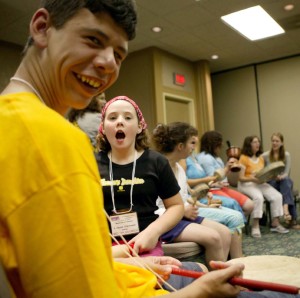 Walking into a large community centre one Friday night, I was gripped with excitement. This was my first time participating in a community drum circle with close to 100 participants. When the drumming began I was astounded by the feeling of being tied together with so many other people through only one thing- rhythm. When finished, we all stood around the room in silence and took turns answering ‘what do you feel?’ Participants answered with a wide range of comments from ‘tired to energized’. This shared experience brought us together, yet individually we were each at our own place in the end. The drum circle provided a sense of group belonging, as well as allowed for individual reactions to the experience.
Walking into a large community centre one Friday night, I was gripped with excitement. This was my first time participating in a community drum circle with close to 100 participants. When the drumming began I was astounded by the feeling of being tied together with so many other people through only one thing- rhythm. When finished, we all stood around the room in silence and took turns answering ‘what do you feel?’ Participants answered with a wide range of comments from ‘tired to energized’. This shared experience brought us together, yet individually we were each at our own place in the end. The drum circle provided a sense of group belonging, as well as allowed for individual reactions to the experience.
This fall, JB Music Therapy began offering drum circles for two very special types of people. FunDrum began for persons with disabilities, and FreeDrum for people coping with chronic illness. Combining drum circle techniques used by a trained music therapist makes for a truly unique program. Many drum circles can provide a shared therapeutic experience but in FreeDrum and FunDrum we do more. Those individual reactions to the music are explored, and utilized to work towards change in the clients we serve. Therapy takes place in both of these drum circles. Here’s why:
Therapy involves a process. When our clients come in to that first drum circle, we are assessing. Assessments happen in verbal and non-verbal form. We may ask a client a question, or we may watch for reactions to sounds and rhythms. In order to establish a relationship with our participants, they are seen over an extended period of time (six weeks) and each drum circle is limited to ten participants.
The process is modified. We take into account our clients reactions, limitations, and needs and then change the music accordingly. We want to make our drum circles accessible to everyone in the group, while creating opportunity for individuals to step out of their comfort zone and overcome challenges. This may mean engaging participants in individual improvisation, or presenting opportunities for someone with a motor challenge to use the mobility they do have to create sound. The group drumming process continues, however allows for an individual’s growth.
The process is addressed. After a drumming activity, the process might be discussed with the group. Aspects of the experience may be related to real life situations, and coping mechanisms explored. Silence can also be a way to address the experience, allowing for clients to absorb their experience and interpret it for themselves.
FreeDrum and FunDrum sessions begin again this week at JB Music Therapy. Click here to find out more about these programs and about the health benefits associated with drumming (research).
Calendar of Drum Circles by JB Music Therapy
Online Check Out our music therapy friends Kat Fulton with Rhythm for Good and Christine Stevens with UpBeat Drum Circles – two music therapists doing incredible work in the area of drumming and rhythm.
In Calgary, we highly recommend Judy Atkinson of Circles of Rhythm for large community drum circles. The Master.
Video of one of the great Drum Circle Facilitators, Barry Bernstein:
Article of Interest:
Armstrong, D. (2002). Drum circles in context: Facilitation and therapy. Progressions, 9, 5-6.
_____________________________________________________________________________
Author : Christine Wensveen, Vice – President of Special Projects at JB Music Therapy
JB Music Therapy is a socially conscious, hard working, talented group of professionals who desire to make a difference.
To book a music therapy session, conference presentation, or purchase a related product visit our website at www.jbmusictherapy.com